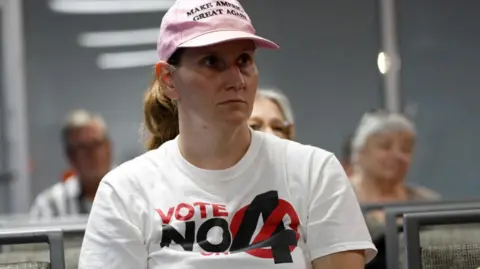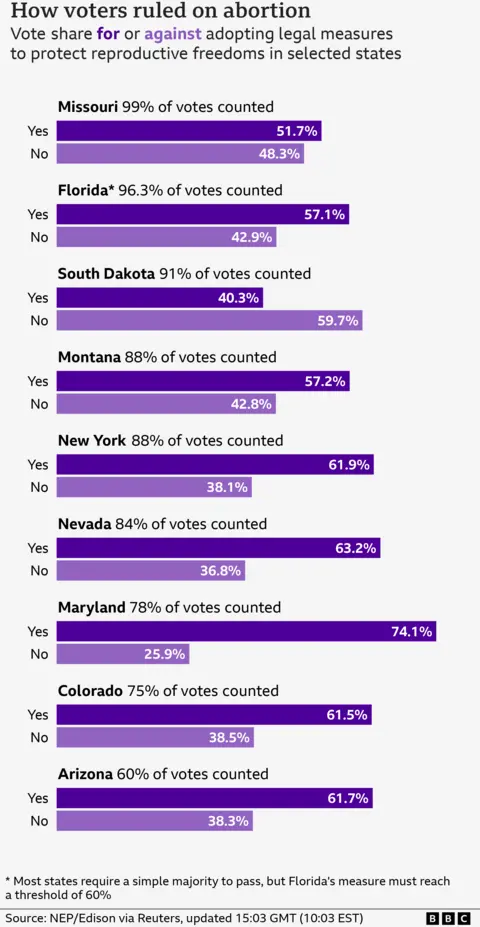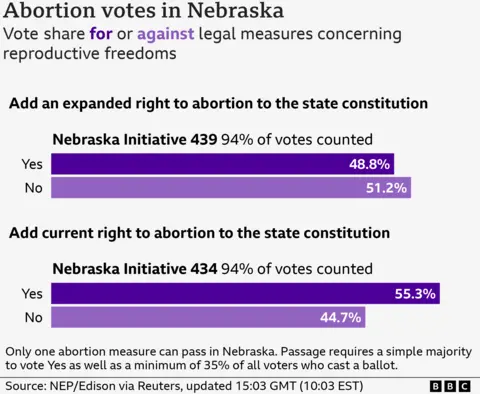Seven US states expanded the rights as Florida’s vote failed

 Reuters
ReutersSeven states in the US have passed measures to protect or expand abortion rights, but bids to restore protections for the procedure have failed in Florida, South Dakota and Nebraska.
The mixed results came as the Republican Party made widespread gains in contests across the US, leading to Donald Trump’s victory.
Voters were asked to weigh in on questions about abortion access in 10 states in this election — the first major presidential contest since the US Supreme Court overturned the national right to the procedure two years ago.
The state-level battles were an attempt by abortion rights campaigners to roll back or preserve access to the practice, after many states banned or restricted abortions following the ruling.
Democrats also hoped the issue would help galvanize voters on their side in the election, crediting anger over the issue with helping the party perform better than expected in the 2022 midterm elections.
Vice President Kamala Harris has leaned on the issue throughout her campaign, appealing to women in all parties.
But that momentum was not always evident this year, as exit polls suggested abortion was placed under topics such as the economy and democracy.

In Missouri, a staunch supporter of Donald Trump, abortion rights campaigners are still seeing a major victory, as voters approved an amendment aimed at overturning the state’s near-total abortion ban.
In Arizona, another state Trump leads, more than 60% of voters support an amendment to protect the right to an abortion until the power is there – about 24 weeks. The measure extends access from the current 15 weeks allowed under state law.
But a similar proposal in Florida fell just short of the 60% support needed to pass, winning 57% support.
Defeat would allow a tough law passed by the government earlier this year, which bans abortions after the sixth week of pregnancy, without restrictions.
The measure was against the force opposition from Republican Governor Ron DeSantis, who used them state resources to persuade voters to vote “no”.
It was also a political headache for Trump, who initially appeared to support the change, but later on he said he would vote against it after being pushed from his team.
Betsy Linkhorst, a first-time voter in Florida, said the result in her state left her “heartbroken, scared and frankly, worried about the future”.
“This was a very important opportunity to protect women’s rights and our ability to make decisions about our bodies,” said the 18-year-old.
Maria McNally, who voted for the amendment, said she believed it would have allowed abortion up until conception.
“I’m glad it failed,” he said.

US voters facing pro-abortion questions in this year’s election come from states with varying degrees of abortion laws.
The questions they were asked to decide also varied, although most efforts proposed establishing the state’s right to abortion until the fetus can continue to live – around the 24th week of pregnancy.
In past election cycles, campaigns to restore or protect abortion access through statewide ballot propositions have been successful, including in conservative states like Kansas.
But the results of this election reinforced the fact that women in the US face very different access to abortion depending on where they live.
Voters in Nebraska and South Dakota rejected measures that would have expanded access, while in Maryland and Colorado, where abortion is currently legal, voters approved measures to enshrine due process rights in the state constitution.
In Colorado’s case, the amendment would also expand access, allowing abortion to be covered under state health insurance plans.
In Montana and Nevada, where abortion is currently legal until it is possible, voters have approved measures to enshrine that right in the constitution.
In Nevada, a majority of voters would have to approve the measure again in two years for the amendment to take effect.
New York, where abortion is legal until possible, approved an amendment that would prevent discrimination based on pregnancy or reproductive health.
In Nebraska, voters faced two abortion programs. They rejected another that would have made the right to abortion possible and approved the current government laws, which prohibit abortion after the 12th week of pregnancy, among others, including having sex with a relative, rape and saving the life of the mother.


Source link





